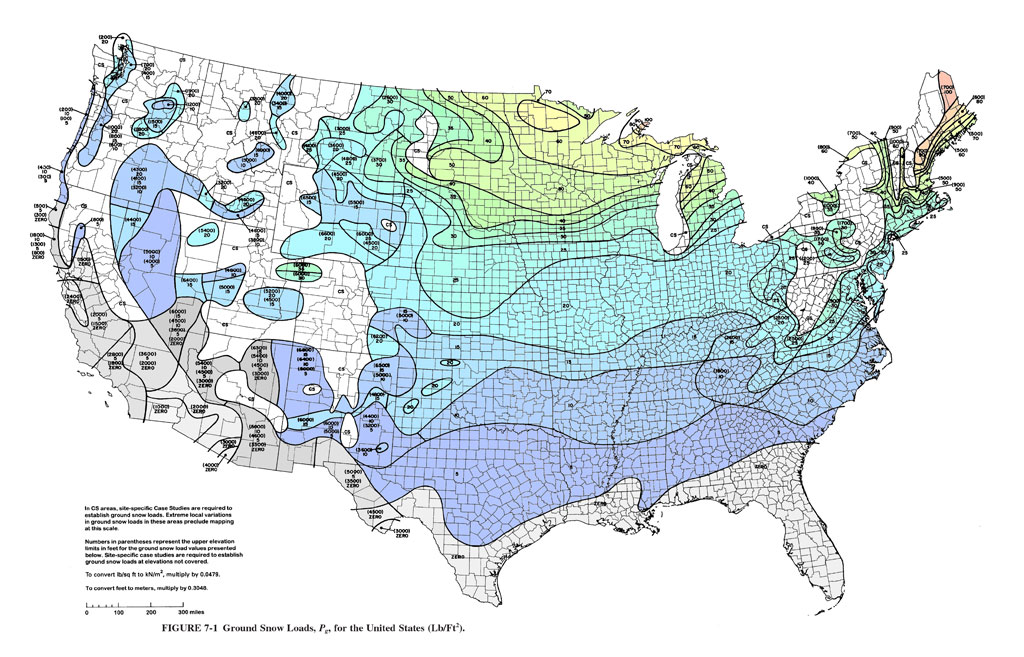Snow Loads
- Roof snow loads are influenced by various factors, including elevation, weather patterns, moisture, slope direction, exposure, roof configuration, and wind severity.
- Overestimating snow loads can lead to unnecessary construction costs, while underestimation can result in premature failure and safety hazards.
- Most building codes in the United States refer to ASCE 7 – Chapter 7 (Snow Loads) for guidance on snow load calculations.
- Roof snow loads are determined based on historical ground snow load records for a specific location. However, it’s crucial to consult with the local building authority for the accurate roof snow load for a particular site and application.
- A ground snow load map from ASCE 7-10 (Figure 7-1) provides a general reference for ground snow loads in the contiguous United States. However, sites with elevations above the indicated limits and those labeled “CS” require site-specific case studies and approval from the governing building authority.
- Ground snow loads for Alaska are provided by Table 7.1 in ASCE 7-10, while Hawaii generally has zero ground snow loads, except in mountainous regions determined by the local authority.
- An interactive ASCE Ground Snow Loads map for the contiguous United States is available for reference.
- Many states have additional snow load data and requirements specific to their jurisdictions. Check out our State Snow Loads page for further details and interactive maps for each state.
- If you need to collect ground snow load data programmatically, consider using our API Service.
Snow Load Calculations
- Snow load calculations for most residential structures follow this method:
- Determine the ground snow load based on location and elevation.
- Calculate the flat roof snow load (pf) using the equation: pf = 0.7CeCtIspg, where Ce, Ct, and Is are factors determined by ASCE tables and most residential structures fall under specific values.
- Check low sloped roofs for minimum snow load as per ASCE Sec. 7.3.4. If pg is less than or equal to 20 psf and slope is less than W/50, apply an additional 5 psf rain-on-snow surcharge load per ASCE Sec. 7.10.
- Calculate the sloped roof snow load (ps) using the equation: ps = Cspf, where Cs is the Roof Slope Factor, and residential roof types have specific values.
- Calculate unbalanced snow loads for hip and gable roofs as shown in ASCE Figure 7-5. These are required for roof pitches between 1/2 on 12 to 7 on 12.
- Various equations, including those for snow density, drift height, width of drift surcharge, and drift surcharge snow load, are used to determine unbalanced snow loads.
- Warm roofs apply a distributed 2pf snow load on all overhanging portions.
- Only dead loads should be present on the roof when this uniformly distributed load is applied.
- While snow load calculations can be complex, they can be easily programmed to simplify the process and eliminate manual calculations and references to ASCE standards.
For immediate service or consultation, you may contact us at Allied Emergency Services, INC.
Contact Information:
- Phone: 1-800-792-0212
- Email: Info@AlliedEmergencyServices.com
- Location: Serving Illinois, Wisconsin, and Indiana with a focus on the greater Chicago area.
If you require immediate assistance or have specific questions, our human support is readily available to help you.
Disclaimer: This article is intended for informational purposes only. For professional advice, consult experts in the field.










